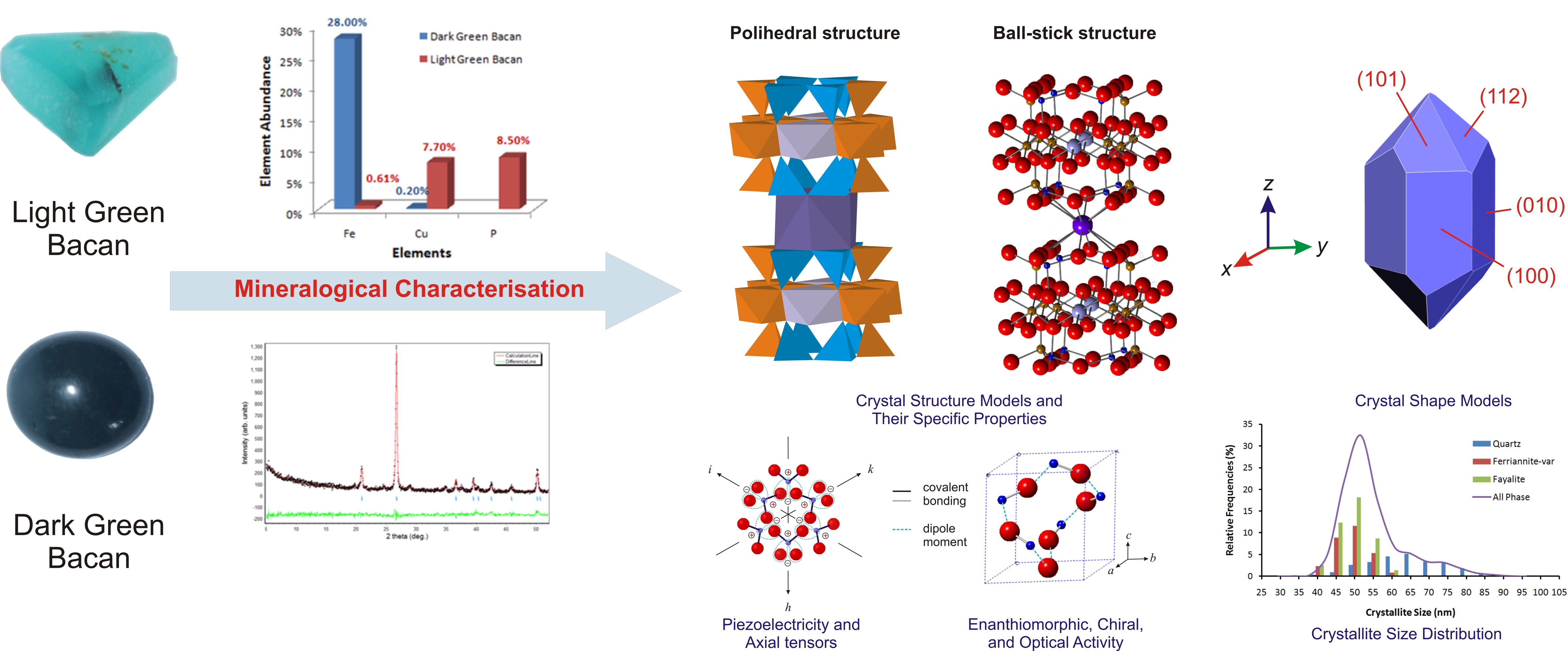Depth Profiling of Dark and Light Green Bacan: Construction of Material Characters Models from Elemental Analysis and Mineralogical Characterization
Abstract

We have demonstrated the evolutional depth profiling methods for local minerals of Bacan in order to establish the sold price and maintenance of minerals sector in Indonesia. The depth profiling methods was performed by elemental analysis and mineralogical characterisation using X-ray fluorescence (XRF) and X-ray diffraction (XRD). We refined materials parameters then constructed the materials models to describe the difference of materials characters. These results described that LG Bacan has crystals phase of Dioptase (CuSiO3), Liebenbergite (Ni2SiO4), and variant of Calderonite (Ca2CuP2O9). DG Bacan has crystals phase of Fayalite (Fe2SiO4), and variant of Ferriannite (KCaFe3Si3O12). All crystals phase in LG Bacan has growth orientation on [001] direction, and has more structured crystallite size with small range of its distribution. All phase in DG Bacan has the preferred growth so, except Fayalite crystal phase. DG Bacan less structured than LG Bacan, with wider range of crystallite size distribution, but has harder structure than LG Bacan. Quartz structure in LG Bacan was more polar than DG Bacan.
References
[1] Chattopadhyay, S., Chattopadhyay, D., Chapter 12: Mining Industries and Their Sustainable Management, in R. Malhorta, Fossil Energy Selected Entries from the Encyclopedia of Sustainability Science and Technology, 2013, Springer, New York.
[2] Rafferty, J. P., Minerals, 2012, Britannica Educational Publishing, New York.
[3] Borchardt-Ott, W., Crystallography, 3rd Ed., 2011, Springer, Heidelberg.
[4] Ministry of Trade of The Republic of Indonesia, Indonesian Gemstones: Exclusively Captivating, 1st Ed., 2010, Trade Research and Development Agency Ministry of Trade, Republic of Indonesia.
[5] Whitfield, P., Mitchell, L., Chapter 6 : Phase Identification and Quantitative Methods, in Clearfield, A., Reibenspies, J.H., Bhuvanesh, N., Principles and Applications of Powder Diffraction, 2008, John Wiley & Sons, Ltd., Oxford, United Kingdom.
[6] Zolotoyabko, E., J. Acta Cryst., 1986, 19, 267.
[7] IUCR Powder Diffraction, 1997, 22, 21.
[8] Howard, C.J., J. Appl. Cryst., 1982, 15, 615.
[9] Donnay, G., Morimoto, N., Takeda, H., Donnay, J.D.H., Acta Cryst., 1964, 17, 1369-1373.
[10] del Tanago, J.G., La Iglesia, A., Rius, J., Fernandez Santin, S., Am. Mineral., 2003, 88, 1703-1708.
[11] della Giusta, A., Ottonello, G., Secco, L., Acta Cryst. B, 1990, 46, 160-165.
[12] le Page, Y., Donnay, G., Acta Cryst. B, 1974, 32, 2456-2459.
[13] Otto, H.H., Meibohm, M., Z. Kristallogr., 1999, 214, 558-565
[14] Ma, C.B., Z. Kristallogr. Krist., 1975, 141, 126-137.
[15] Downs, R. T., Hall-Wallace, M., Am. Mineral., 2003, 88, 247-250.
[16] Kaminsky, W.J., J. Appl. Cryst., 2005, 38, 566-567.
[17] Kaminsky, W.J., J. Appl. Cryst., 2007, 40, 382-385.
[18] Larson, A. C., von Dreele, R. B., Los Alamos Nat. Lab. Report, LAUR, 2000, 86, 748.
[19] Balzar, D., Popa, N. C., The Rigaku J., 2005, 22(1), 16-25.
[20] Lyubomirova, V., Smit, Z., Fajfar, H., Zlateva, B., Djingova, R., Kuleff, I., Mediterranean Archeol. Archeometry, 2015, 15 (2), 257-275.
[21] Supriadi, M.B., Chen, M.C., Li, Y.S., J. Pure. App. Chem. Res., 2013, 2(1), 1-10.
[22] Nivorozhkin, A.L., Toflund H., Edu. Chem., 1994, 1, 22-24.
[23] Gautier, R., Klingsporn, J. M., van Duyne, R. P., Poeppelmeier, K. R., Nature Mater., 2016, 15, 591-592.
Refbacks
- There are currently no refbacks.









